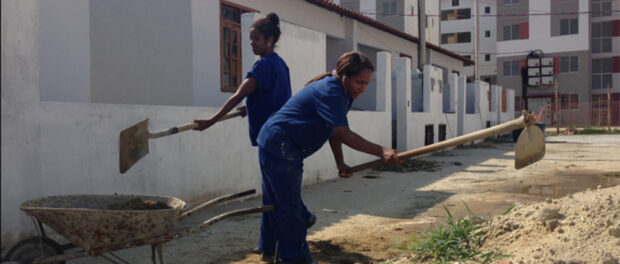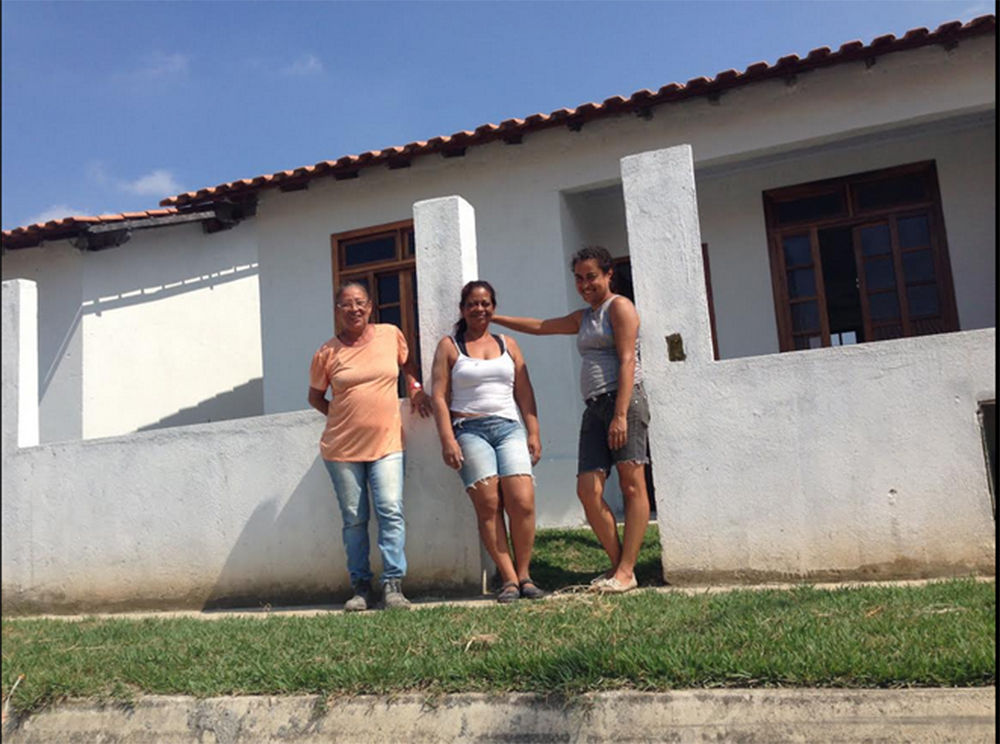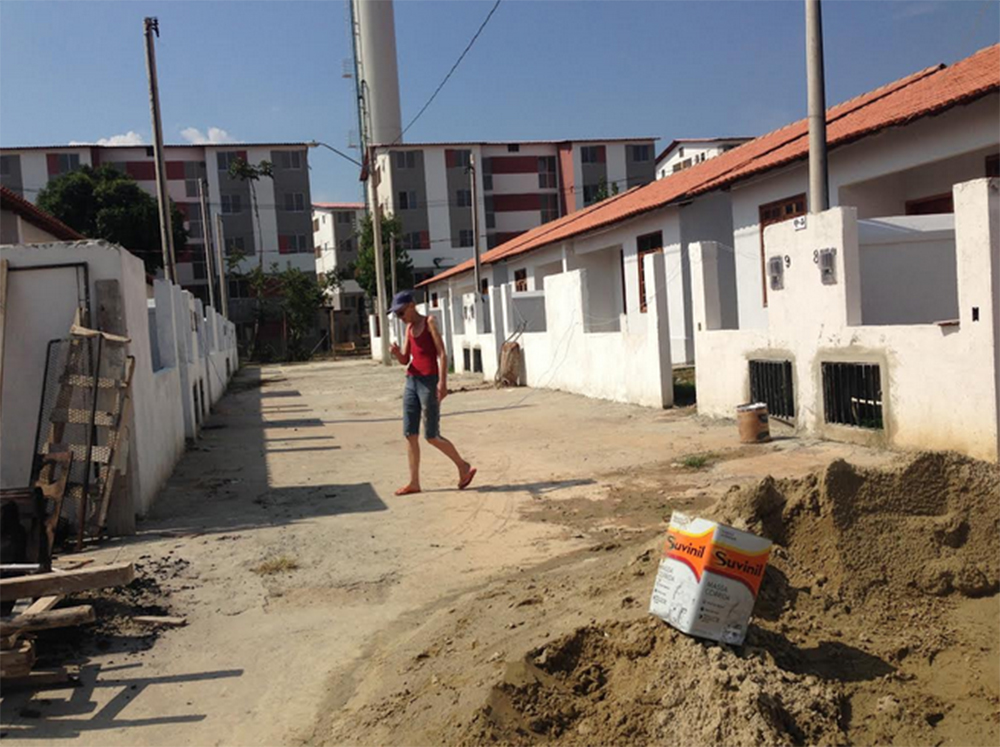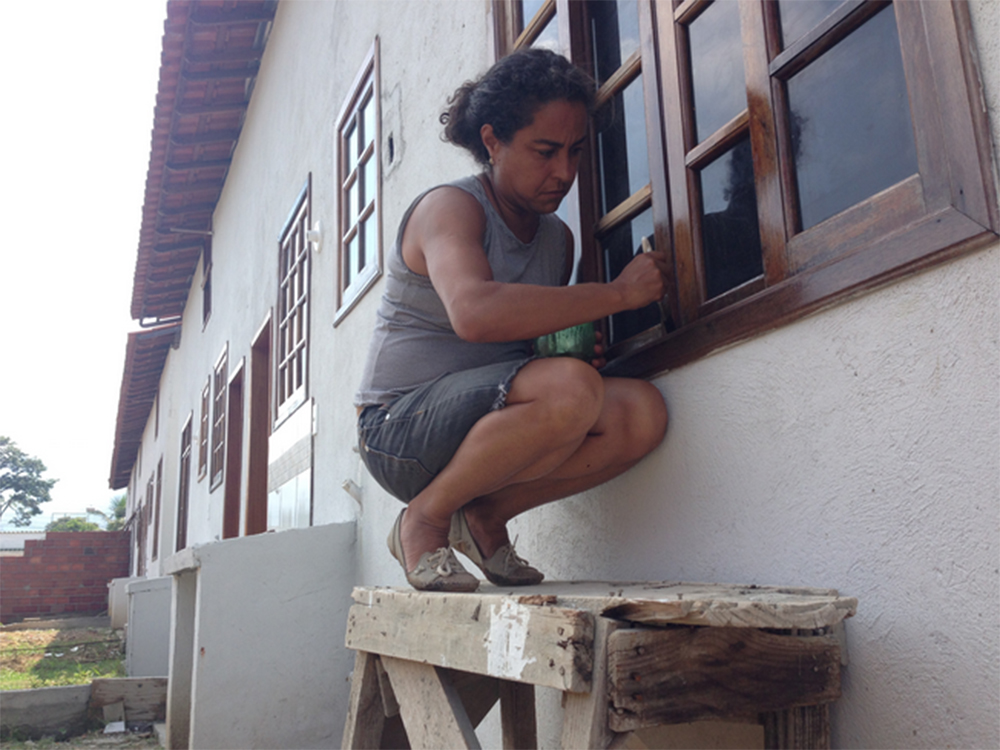
For the original in Portuguese by Camila Nobrega, published in Canal Ibase, click here.
In the doorway of one of the houses under construction in the Condomínio Esperança (Hope Condominium)—built by the housing cooperative by the same name in the Juliano Moreira neighborhood in Rio’s West Zone—three pairs of black boots covered in mud announce that Sunday is a synonym for hard work. In the living room, still lacking furniture, three smiling faces wait to speak. Maria do Carmo Martins—also known affectionately as Carminha—Maria Ribamar Figueiredo Freitas, and Vanilsa Queiroz Motta quickly begin to talk about the site’s construction project, while they let the weight of exhaustion overcome them. “It was four years of a lot of work, a lot of production and little rest, but I am proud to say that I built every little piece of my house. I am going to fight much more to make this place a special place to live,” says Ribamar, who is a manicurist and caretaker of the elderly.
Over the past four years, along with her Monday-to-Friday job in a beauty salon and nursing homes, Ribamar contributed 17 hours every week so that the Esperança housing collective project could become a reality. Within her family, she only had the help of her teenage granddaughter, who will live with her. She also received help from other future residents, whose sense of solidarity grew over the course of their work.
Along with Maria do Carmo and Vanilsa, Ribamar is part of a group of 70 families who will soon arrive at the site with suitcases and many ideas. As soon as the residence is approved, they will move to the Esperança condominium, built entirely by its own residents. In reality, it was mostly built by women, female heads of households, as Vanilsa points out. “If my house is now standing and beautiful, it was because of my work, because I put aside my vanity and leisure in recent years,” she says, showing her nails, dirty with grease, and her hair tied back, “and because of the help of the women. Of course, the men helped too, but Esperança is being born out of a lot of hard work by the women—those who are single, like me, and also those who are married but don’t have the support of their husbands. It was us women who did the dirty work.” Vanilsa, who works as an administrative assistant, is moving from Taquara to the new condominium in Juliano Moreira neighborhood, where she will no longer have to pay R$420 (US$135) rent for a one-bedroom apartment.
Brick by brick, the houses went up these past few years in a collective fashion. Cement, wiring, finishing. Everything done by hand by future owners of the homes, the majority of them without prior experience in building. The knowledge also came from within the collective.

Esperança will be the first housing cooperative launched in Rio de Janeiro with resources from the Minha Casa Minha Vida-Entidades (MCMV-En) program, created in 2009 by the federal government and still little known in the majority of Brazilian states. Linked to the National Secretary of Housing of the Ministry of Cities with resources from Caixa Econômica federal bank, Entidades arose after much struggle by social movements for the right to housing, with the objective of making this right accessible to families organized through housing cooperatives and associations. In practice, the proposal is to promote self-management and make it possible for residents themselves to take part in the whole process of planning and building the housing projects, in contrast to what happens in the traditional process of the [much-criticized mass-production model of the] Minha Casa Minha Vida (MCMV) program.
The beneficiary families have monthly incomes between R$0 and R$1,600. A monthly contribution is calculated according to the income each family declares at the beginning of construction and begins the moment the family moves to the new home. Everyone will continue making monthly payments for over the next ten years.
A 10-year struggle to complete the condominium
The work to build the Esperança condominium began ten years ago with meetings. All of the residents signed up with the goal of fighting for their own housing, and they could not miss the meetings without good reason. In 2011, resources for the project were released. Instead of relief, another difficult phase began: the immense investment of each family to build the houses. As Jurema da Silva Constâncio says: “There are many steps until you get a house. First, years of meetings before mobilizing the resources. Then, all of the effort in the construction, and, finally, the challenge of maintaining all of this after everyone has the keys to their houses. The collective management is always challenging and difficult, but without a doubt it will bring us a better quality of life. The residents chose their building materials. And each one can choose some details, like tiles, for example. In other words, we can put our own touches on our own housing.”

Jurema is one of the leaders of the project. She is a member of the National Union of Popular Housing, a movement that spearheaded this fight in the West Zone, where the first condominium built under a self-management model, Shangri-lá, was created. Launched over ten years ago, well before the creation of Minha Casa Minha Vida-Entidades, Shangri-lá also arose from the self-organization of residents. A favela by the same name occupied the space, in the Juliano Moreira neighborhood. Jurema lived there in a small wooden house and, at the time, worked in a family’s home. She had never participated in social movements until she learned about the struggle for housing in church groups she attended. She realized that the home-work routine would never change if she didn’t take part in the fight for change. It was then that she joined the social movement, never to leave, especially because the right to housing is on the list of the most violated rights in the country. There are already other projects on the path to approval by Minha Casa Minha Vida-Entidades. But many issues prevent resources being freed up. The Caixa Econômica bank, like the majority of federal agencies, has not adapted itself to deal with cooperatives instead of large companies. Because of this, there is a lot of bureaucracy to initiate a project.
The results of the self-managed projects are incomparable to those of the traditional Minha Casa Minha Vida program, in which the apartments are made by large contractors in a patronizing and impersonal manner. That is what residents report where the Entidades program has grown the most—São Paulo. And this is what can be observed in the Juliano Moreira neighborhood. The differences are glaring and even more visible there, because the City of Rio decided to build a housing complex in the conventional model of the project right beside Esperança.

Behind the little houses built by residents, a building constructed under the traditional Minha Casa Minha Vida standards calls attention. While a walk through Esperança reveals families working in each home, putting on the finishing touches, the other condominium is vacant. The condominium awaits residents coming from various parts of Rio de Janeiro, the majority of whom have never met before. Each one gets a key and moves in. There is no connection to the area. Not to mention the building, which was built following standards that haven’t changed since the BNH project. The same condominium could be there, in Queimados as is the case of this Valdariosa complex, or in any other place.
On the other hand, the sense of belonging, of collectivity, and of solidarity are exactly the elements that are obvious in the Esperança complex. In each house under construction, the future resident was rarely the only one working during the period of construction and finishing. Each future resident was certain to have the company of neighbors for all jobs. One day finishing the windows of one home, another day finishing the tiling of another, and on a third day varnishing the doors of the house of a third family. On the streets of the complex, final touches are being made. Mother and daughter, Simone and Juliete Pinto, 42 and 24 years old, with blue uniforms they bought themselves for the job, separate leftover soil to make a garden. “We live in Curicica and we can’t wait until we can move. I worry about the lack of water in this region and the infrastructure and other things. But just to have my own house, I feel that it was well worth the many years of work and the years of youth that my daughter gave up for this house,” says Simone.
In contrast to the silence of the building out front, Esperança is full of life, as it was long before it was ready, giving meaning to the word that gives it its name, Portuguese for “hope.” In the cafeteria, every day lunch is guaranteed by a cooking rotation system. Cooking also adds to the hours of time donated to the project. Everyone comes in with a basket of basic food at the beginning of the month. In this way, there is food for everyone who is working. And it is delicious.
However, it’s not all fun and games. On the eve of the launch, each person that contributed feels the weight of four years of a lot of work. Civil construction is far from easy. Back pain, foot pain, untreated health problems. These are issues that arise given the quantity of work and lack of experience people have with building a house. As Alfredo Sobral says: “Everyone, man and woman, works hard. Maybe there is a way of doing this project that could be less stressful. Today, for example, my wife is in a meeting, and I’m building the house.”
Researcher Luciana Lago, professor at the Urban and Regional Planning Institute of the Federal University of Rio de Janeiro and one of the main authorities on Minha Casa Minha Vida-Entidades program, emphasizes that there are choices to be made by each group upon receiving the resources. “There are groups that have enough to hire other cooperatives to do a few services. It becomes less responsibility for the residents. There are excellent cases in São Paulo. On the other hand, there are also cases of housing complexes that completely stray from the initial objective of Entidades.”
Luciana Lago stresses the importance of the resources designated to the Entidades program, which are still very scarce, adding up to about only 1% of the whole Minha Casa Minha Vida project. However, based on years of research on the topic, the researcher identifies some issues with the course the program is taking in a few cases. Following the argument that the model needs to be replicated on a large scale, projects surface that are not managed, as intended, by cooperatives.
According to her, there are resources directed towards the program that end up in the hands of large contractors by means of contracting processes that often are initiated by the companies themselves, after approaching the communities: “The problem is not the large scale itself, of course, because it is necessary to do many more projects. The question is what we are giving up. Entidades was born in a beautiful way, as a consequence of the organization of people fighting for housing and with the intention that those same residents decide everything about their future homes. The rush to build doesn’t go well with the development of people, with the time required for self-management to become real. This is an equation that we need to revise, but without hindering the process, as is happening.”
There are some instances in regions of Brazil like São Paulo where complexes built with resources from Entidades are ready in less than two years, from the beginning to the end of the process. Could there really be self-management by residents in these cases? This is one of the questions that is put to the social movements that accompany these processes. “In any event, Entidades has beautiful examples, very different from the traditional Minha Casa Minha Vida program, which became a depository of very low-income people in zones of the city without any infrastructure,” emphasizes Luciana Lago. She cites examples of projects such as the Paulo Freire housing complex, very famous in São Paulo, and other cases of condominiums made with resources from Entidades in the south of the country, which generate not only houses but also new cooperatives created among residents for income generation, such as Cometal, a cooperative of metalworkers.
The country needs to continue growing, but this growth must be inclusive, and we cannot give up at any cost. This is one of the conclusions of researchers Mariana Simpson and Francisco Menezes of the Brazilian Institute of Social and Economic Analysis (Ibase). According to their study on poverty and inequality, during recent years the country saw an increase in investments aiming for economic growth but which ended up generating more exclusion. Minha Casa Minha Vida is part of this analysis and is identified as an example of this phenomenon. The program leaves the building of millions of residential units predominantly in the hands of large contractors and ignores basic needs, such as the importance of being located in areas with infrastructure, sewerage, public transportation, equipment, and urban and social services. This neglect makes access to social and economic development opportunities even more impractical for residents.
“Both in Minha Casa Minha Vida and Minha Casa Minha Vida-Entidades, the realization of the dream of owning one’s own home is very significant for these families. However, housing cannot be understood as four walls and a roof. It is a gradual and personal process, one of building a community and, consequently, a city. This is what the Esperança group has been building together, ferociously, in the past four years,” asserts Mariana Dias Simpson, researcher with Ibase.
